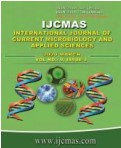


 National Academy of Agricultural Sciences (NAAS)
National Academy of Agricultural Sciences (NAAS)

|
PRINT ISSN : 2319-7692
Online ISSN : 2319-7706 Issues : 12 per year Publisher : Excellent Publishers Email : editorijcmas@gmail.com / submit@ijcmas.com Editor-in-chief: Dr.M.Prakash Index Copernicus ICV 2018: 95.39 NAAS RATING 2020: 5.38 |
An experiment on “Evaluation of factors affecting modulus of rupture as an index of crusting in soils of Haryana” was carried out during 2016-17 at Chaudhary Charan Singh Haryana Agricultural University, Hisar, Haryana. The soil samples were collected from 21 locations from farmers’ fields in from 0-5 and 5-15 cm depths from different districts of the Haryana having wide range of texture ranging from sand to silty clay loam. The effect of different physico-chemical properties of these texturally different soils was evaluated on their modulus of rupture (MOR) values. The organic carbon, aggregate size analysis, mean weight diameter and modulus of rupture of all the soils were determined using standard methods. The effect of different soil properties on modulus of rupture of soils was evaluated. The MOR of different textured soils at both the depths (0-5 and 5-15 cm) was significantly positive and lineally correlated with the soil organic carbon contents of soils with R2 value of 0.74 and 0.75 for 0-5 and 5-15 cm depths. The water stable aggregates at 0-5 and 5-15 cm depths were found significantly positive and linearly correlated with organic carbon content of soils. The water stable aggregates were highest in silty clay loam (67.42%) and lowest in sand (30.85 %) at 0-5 cm depth. Aggregate stability index as mean weight diameter (MWD) was observed to be higher in fine textured soils as compared to coarse textured soils. The silty clay loam soils were found with highest MWD of 1.61 mm and 1.54 mm at 0-5 and 5-15 cm depth amongst all the soils respectively. The MOR was found highly dependent on silt + clay and water stable aggregates.
 |
 |
 |
 |
 |